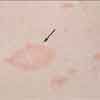Pityriasis Rosea and Hot Tub Folliculitis
A 17-year-old boy presents with a red, scaly rash on his trunk that began as a single lesion on his left flank. The generalized eruption had developed within 24 to 48 hours. The patient's father has psoriasis.

Case 1:
A 17-year-old boy presents with a red, scaly rash on his trunk that began as a single lesion on his left flank. The generalized eruption had developed within 24 to 48 hours. The patient's father has psoriasis.
Does this patient also have psoriasis, or is this skin condition unrelated?


Case 1: This young man has pityriasis rosea. The hallmark of this condition is the herald patch (arrow),which is thought to be present in 40% to 60% of all patients with pityriasis rosea. It is usually a solitary, round, or oval lesion that can occur anywhere; however, it is predominantly found on the upper arms and trunk. When the herald patch first occurs, it does present the possibility of tinea corporis or a single patch of psoriasis. However, the development of a generalized eruption within a week is quite characteristic of pityriasis rosea.
The secondary eruption is of similar morphology to the herald patch, but the lesions are usually much smaller. Lesions number from few to many and usually appear within 1 to 2 weeks of the herald patch. Individual lesions have a collarette scale, with the scale attached at the periphery and the free edge pointing inward.
Their typical distribution has been termed T-shirt and shorts. Fewer than 15% of affected patients have involvement distal to the elbows and knees. The face is generally spared, as are the palms and soles. The characteristic distribution on the trunk has been described as an inverted-Christmas tree pattern, with the oval lesions running parallel to the ribs. I have found it useful to examine the axillae, where the oval lesions form an arciform pattern.
Half of patients with pityriasis rosea report moderate to severe itching. This is usually controllable with mid- to high-potency topical corticosteroids applied to individual lesions with the addition of systemic antihistamines. Phototherapy with UV-B light or significant sun exposure can also be helpful.
Pityriasis rosea generally resolves spontaneously at about 12 weeks. The eruption usually occurs once in a lifetime, but about 2% to 3% of patients experience a relapse.
There are multiple variants of pityriasis rosea. The most common is inverse pityriasis rosea, in which the lesions occur only in the flexural areas. The morphology is similar and the diagnosis is made on the basis of the linear array of lesions of typical morphology. The humidity in most flexural areas minimizes the presence of collarette scales.

Case 2:
This adolescent girl presents with a 1-week history of tender pustules on her trunk. Her primary care physician prescribed cloxacillin. Despite 4 days of therapy, there is no sign of resolution.
The patient's answer to a single question will give you the diagnosis . . .

Case 2: This young girl has hot tub folliculitis. This is a common condition during the winter ski season when one of the popular après-ski events is to gather in a hot tub. Those who become infected usually present with a rash that starts within a few hours to a week after the hot tub experience.
The lesions themselves may be tender to touch. There are usually large numbers of clustered erythematous papular pustules that are accentuated in the bathing suit area. The clinical clue is that these lesions usually have significant erythema with a very small pustule in the center of intense inflammation. A culture of the pustule and the single history question about hot tub exposure is generally sufficient to confirm the diagnosis.
Pseudomonas aeruginosa is the responsible organism. It survives in hot tubs, especially those made of wood. It is particularly problematic when pH and chlorine levels are not closely regulated. It is not unusual for a majority of those who bathed in the hot tub to become infected. Many people have been infected at a single time by contaminated hot tubs at recreational centers and hotels. Otitis externa, pharyngitis, conjunctivitis, rhinitis, and mastitis have all been associated with the cutaneous infection.
I advise owners of hot tubs to pay close attention to maintaining disinfectant levels, particularly if the water is kept at high temperatures. Once someone has become infected in a hot tub, I recommend that the tub be drained and all surfaces and tubing be wiped down with a bleach solution before the tub is refilled. The owner must then take meticulous care of the water to prevent recurrences.
Hot tub folliculitis is usually self-limited, but persons with severe inflammatory disease or those with underlying immunosuppression should be treated systemically.